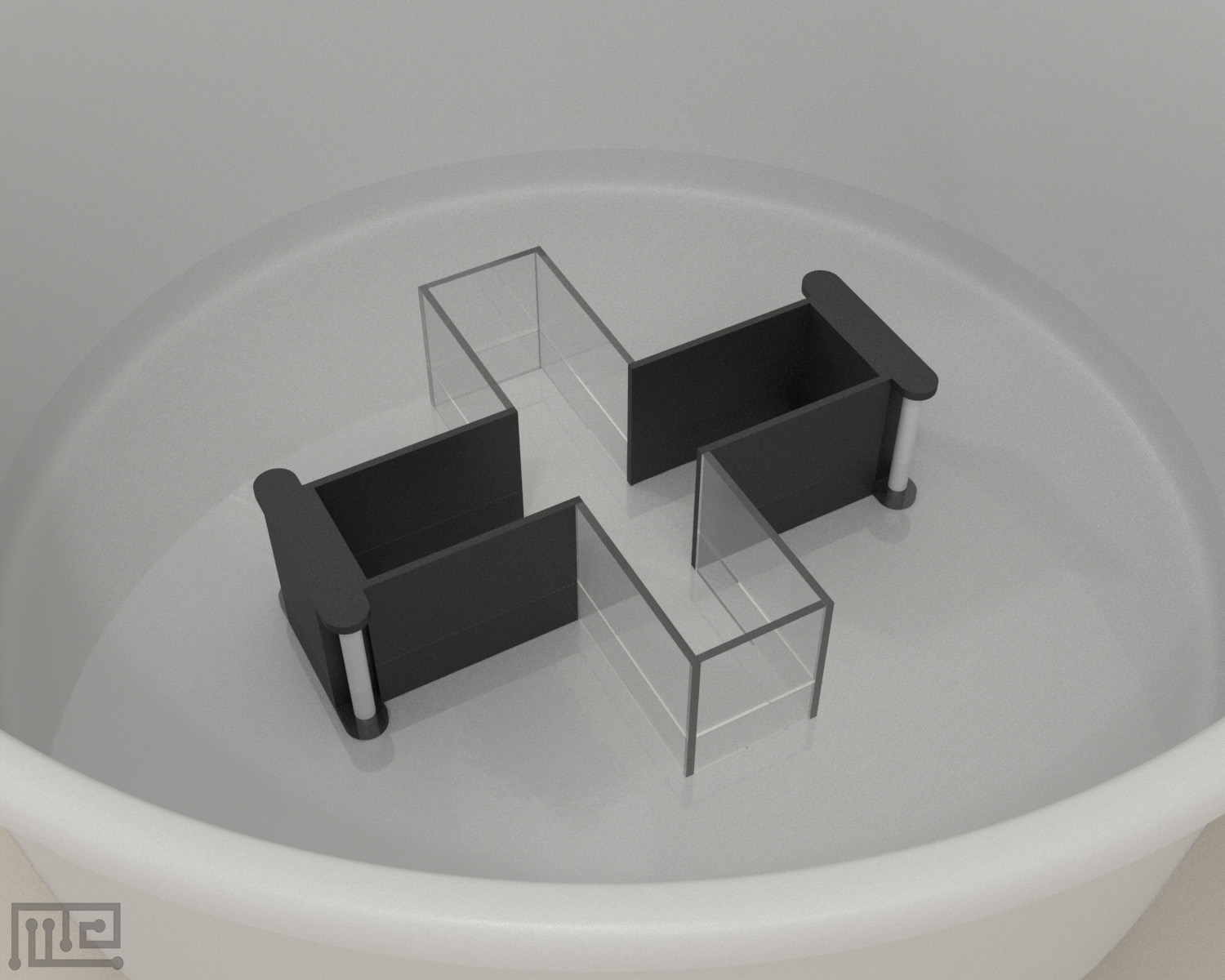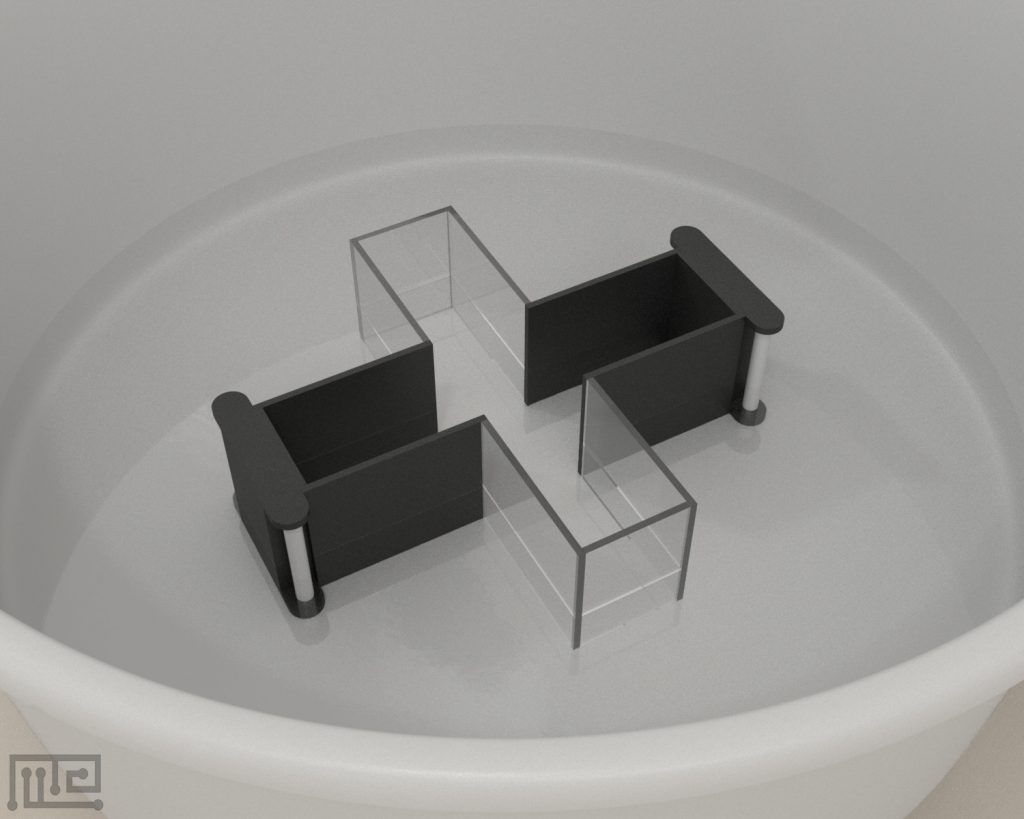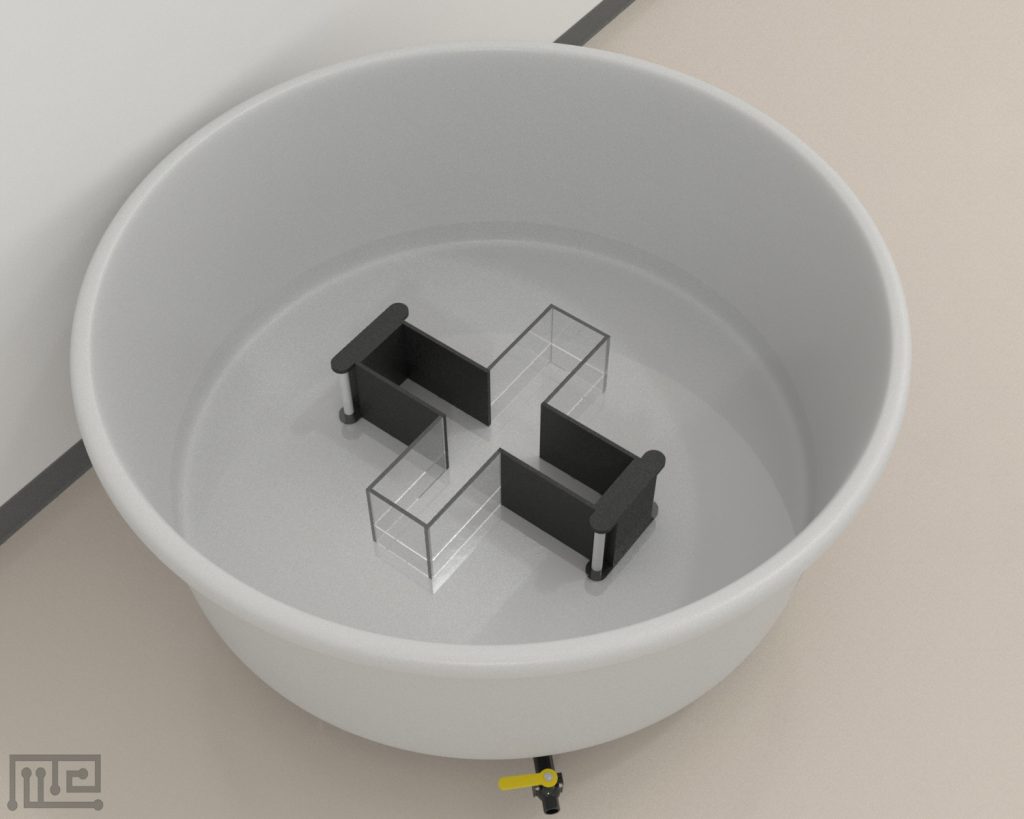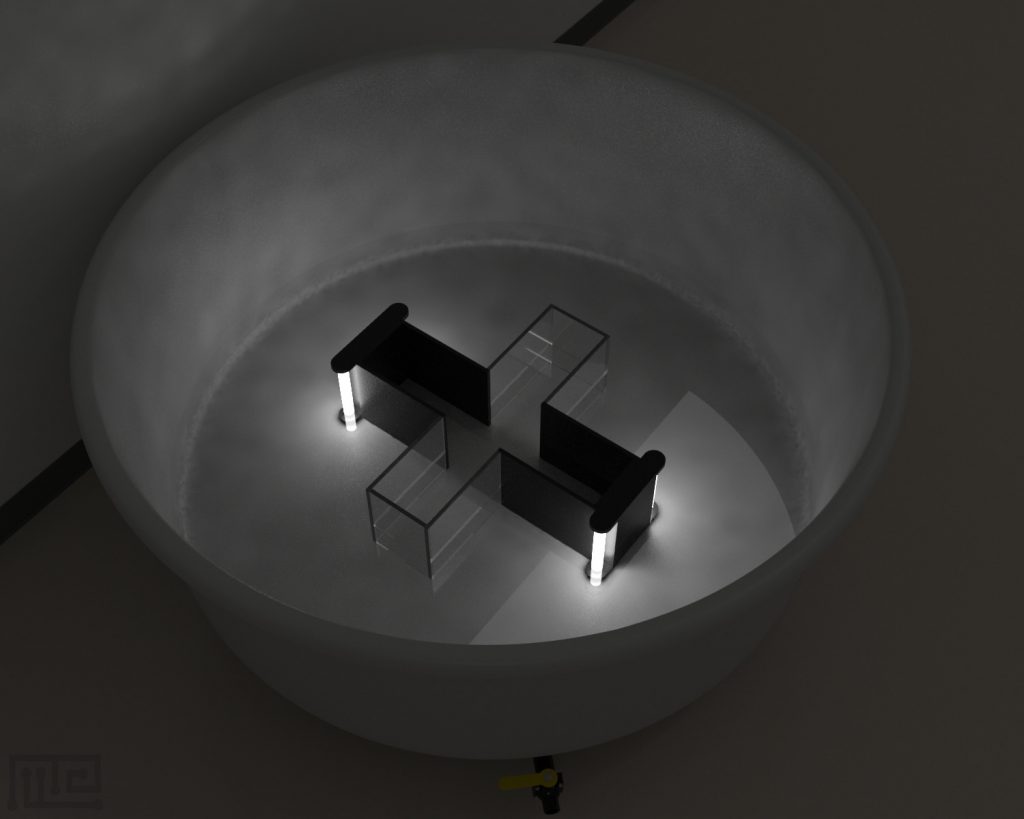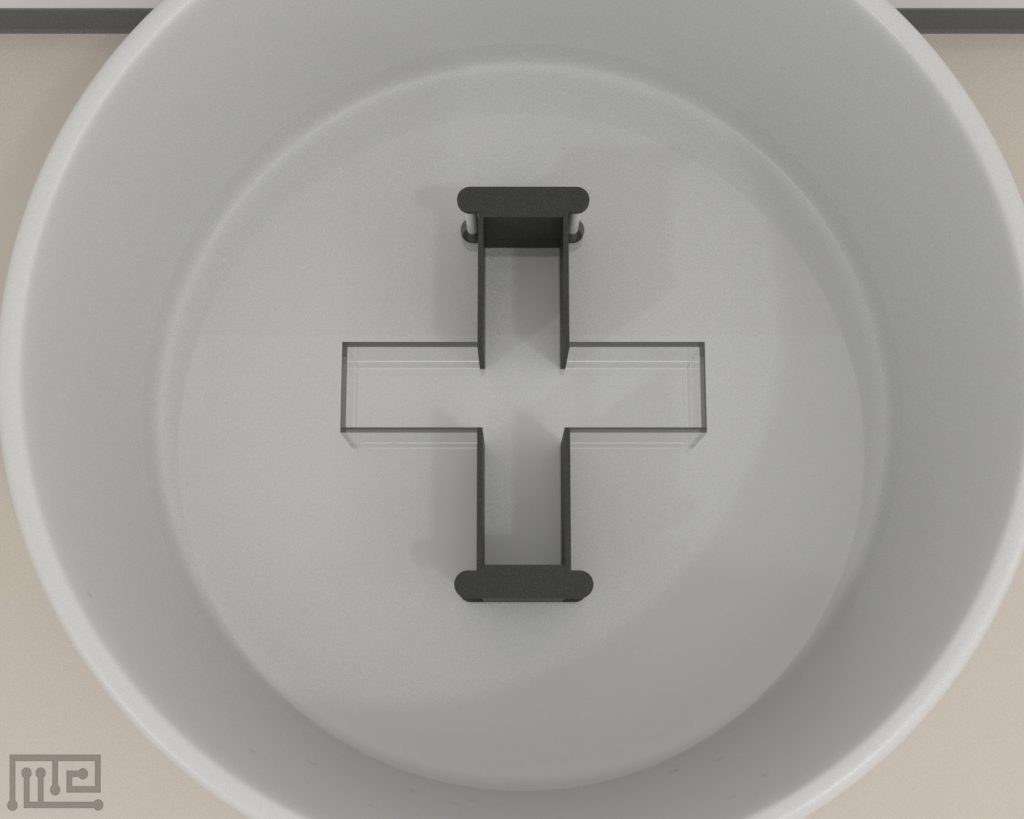The Crayfish Light Dark Maze was used for measuring anxiety-like behavior in crayfish by using a sub aquatic dark-light plus maze.
It is a customized apparatus adapted to the size of adult crayfish. Smaller or larger dimensions might be necessary for young crayfish or other species.
The illuminated arms were made of transparent Plexiglas and dark arms of opaque Plexiglas. Illumination of the light arms is performed by a series of LEDs disposed outside the plus maze, on the outward side of the dark arms on the outmost extremities.
Mazeengineers offers the Crayfish Light-Dark Maze. note the external tub requires a separate order of the MazeEngineers Morris Water Maze
Price & Dimensions
Crayfish Light-Dark Maze
$ 990
+S&H- Total length of maze: 65cm
- Length of each arm: 25cm
- Width of each arm: 15cm
- Diameter of round tank where maze is placed: 1.5m
Documentation
Introduction
The Crayfish Light Dark Maze is used to observe exploratory behaviors in crayfish, which can be used to assess anxiety-like behaviors. It is a sub-aquatic maze, which contains four-choice arms that are connected, forming a plus-shaped apparatus. Two of the choice arms serve as the maze’s light arms and are made of transparent Plexiglass walls, which allow them to be illuminated from the outside. In contrast, the two remaining arms are made of opaque, black Plexiglass, and make up the maze’s dark arms. The Crayfish Light Dark Maze utilizes the same anxiety assessment protocol as the Light/Dark Box.
Crayfish tend to prefer dark places, even though they generally love exploring new environments. Their preference for dark places increases as a result of stress, which induces anxiety-like behaviors (Fossat, Bacqué-Cazenave, De Deurwaerdère, Delbecque, & Cattaert, 2014). The Crayfish Light Dark Maze allows observation of preference behaviors towards light or dark environments by providing the subjects with lit and dark arms. Moreover, it can effectively be used to observe the effect of various stressors such as social stress, changes in environmental parameters, or electric field stress on anxiety-like behaviors. The subjects having increased anxiety-like behaviors tend to avoid the light arms of the maze. Various other behavioral patterns that indicate anxiety-like behaviors can also be observed on the Crayfish Light Dark Maze, such as the total distance moved during trials or the number of attempts or retreats from each maze arm.
The Crayfish Light Dark Maze can also be used to observe the effect of brain lesions and diseases on anxiety-like behaviors. Moreover, the effect of pharmacological manipulations, such as anxiolytic drugs, can also be observed. Other apparatuses used in evaluating anxiety-like behaviors in other animals include the I Maze, the Successive Alleys Test, the Tail Suspension Test, and the Novel Object Recognition Test.
Apparatus and Equipment
The Crayfish Light Dark Maze is a plus-shaped (+) sub-aquatic maze that measures 65 x 65 cm in length and 20 cm in height. Each arm of the maze measures 25 cm in length and 15 cm in width. The middle zone, which serves as the start point measures 15 x 15 cm. Two arms of the maze serve as the light arms and are made of transparent Plexiglass walls, while the two other arms are made of opaque, black Plexiglass walls and serve as the dark arms. Light is provided by four light sources that consist of two LEDs each and are attached on the outer side of each dark arm on their utmost extremities. The Crayfish Light Dark Maze is placed in a larger circular tank that measures 1.5 cm in diameter.
Training Protocol
Remove the freshwater from the maze and replace it with new freshwater after testing. A tracking and recording system such as the Noldus Ethovision XT can be used to assist with observations.
Crayfish Light Dark Maze Task
Switch off the water oxygenation pump of the tank. Switch the LED sources of the Crayfish Light Dark Maze on, and the room light off. Adjust the white LED intensity to generate 50-lux intensity in the light arms and 10-lux intensity in the dark arms. Place a subject in a small opaque tank and then place the tank in the middle of the maze. After 1 minute, release the subject from the opaque tank and let it explore the maze for 10 minutes. After 10 minutes, remove the subject from the maze and place it in its home tank. Activate the oxygenation pump for 30 seconds. Perform another trial on another subject.
Literature Review
Investigation of social stress on anxiety-like behaviors in crayfish
Bacqué-Cazenave, Cattaert, Delbecque, and Fossat (2017) investigated the effect of social interaction on anxiety-like behaviors in crayfish. Male crayfish (Procambarus clarkii) were used in the study and were isolated for three weeks before the experiment. After the isolation period, paired subjects were placed in a fight aquarium for 20 minutes to observe their social interactions to determine the fight’s winner and a loser. Aggressive behaviors, which included the number of approaches towards the other subject, and the number of attacks were analyzed. In addition, defensive behaviors, which included the number of escapes and the number of tail flips, were also recorded. After social interactions, the subjects were tested on the Crayfish Light Dark Maze to measure their anxiety-like behaviors. Individual subjects were placed in the apparatus, and their exploratory behaviors between the light and dark arms of the maze were analyzed. Results indicated that the winner explored both the light and dark arms of the maze, while the losers restricted their exploration to the dark arms. Control subjects that were isolated but did not perform social interaction trials also explored all the arms of the maze. Therefore, a significant increase in anxiety-like behaviors was observed in the losers. The losers were then injected with Methysergide maleate salt (5-HT1 and 5-HT2 blocker) 10 minutes before agonistic interactions or injected with chlordiazepoxide hydrochloride (CDZ) an anxiolytic drug, after the 20-minute social interaction session. Results indicated that CDZ abolished anxiety-like behaviors in the subjects since they explored and spent time even in the light arms of the maze as compared to the losers injected with saline. The subjects’ brains were then rapidly extirpated and weighed to measure their 5-hydroxytryptamine (5-HT) concentration in the brains. It was observed that the losers’ brains contained a higher amount of 5-HT concentration as compared to the controls and winners. Methysergide, which is a broad-spectrum 5-HT antagonist, prevented anxiety-like behaviors in the losers; however, it did not cause the losers to retreat during social interactions.
Investigation of the effect of serotonin and dopamine on anxiety-like behaviors in crayfish
Fossat, Bacqué-Cazenave, De Deurwaerdère, Cattaert, and Delbecque (2015) investigated the roles of serotonin and dopamine on anxiety-like behaviors in crayfish. One hundred and thirty male crayfish (Procambarus clarkii) were first isolated for three weeks and then subjected to electric field stress of various intensities. Behavioral testing was performed on the Crayfish Light Dark Maze to measure anxiety-like behaviors. The subjects were placed in the center of the maze, and their exploratory behaviors were analyzed. After behavioral testing, the subjects’ brains were rapidly extirpated and weighed to measure their 5-HT and DA concentrations. Results indicated that electric field stress elicited aversive reactions in the subjects and induced anxiety-like behaviors in the Crayfish Light Dark Maze. However, electric field intensity lower than 4mA did not elicit anxiety-like behaviors. Anxiety-like behaviors were observed at 4mA intensity and progressively increased at higher intensities. Analysis of 5-HT levels and DA levels indicated that the unstressed control subjects showed significantly higher 5-HT levels as compared to DA levels. The induction of stress caused 5-HT levels to increase even higher, with a 69% increase from unstressed controls. Moreover, the high amount of 5-HT significantly correlated to the percentage of time spent in the light arms of the maze and retreat ratios. The subjects were also injected with either 5-HT or DA to measure their effects on stress and anxiety-like behaviors and blood glucose levels. It was observed that 5-HT, but not DA, caused a significant increase in blood glucose. The effect of 5-HT antagonists on anxiety-like behaviors was also analyzed. The subjects were injected with a mix of mianserin hydrochloride, a 5HT2 blocker, and methysergide maleate salt, a 5HT1, and 5HT2 blocker before 5-HT injection. The effect of 5-HT was abolished when 5-HT has injected after the mixture 5-HT antagonists. The effect of anxiolytic chlordiazepoxide (CDZ) injection on anxiety-like behaviors and bioamine levels were also analyzed. Results indicated that CDZ was able to abolish anxiety-like behaviors by restoring the time spent in the light arms of the maze and decreasing retreat ratios. Overall, results indicated that 5-HT, but not DA, played a significant role in anxiety-like behaviors.
Data Analysis
The following parameters can be observed using the Crayfish Light Dark Maze:
- Total distance moved
- Time spent in the dark arms of the maze
- Time spent in the light arms of the maze
- Latency to enter a light arm
- Latency to enter a dark arm
- Mean number of entries into the light arms
- Mean number of entries into the dark arms
- Mean duration per visit in the light arms
- Mean duration per visit in the dark arms
- Number of retreats from entering a light arm
- Number of retreats from entering a dark arm
- Retreat ratio (number of retreats / total number of attempts)
Strengths and Limitations
Strengths
The Crayfish Light Dark Maze is used to observe anxiety-like behaviors in crayfish. The bright arms of the maze can be used to observe Crayfish aversion to bright spaces, which indicates stressful responses. It can effectively be used to measure the effect of various stressors such as social stress, water quality, and other environmental contaminants on the exploratory behaviors of the subjects. Moreover, it can also be used to observe the effect of different drugs such as anxiolytic or anxiogenic drugs on exploratory behaviors. Pre-training is not required on the apparatus, and testing usually includes a single trial so that the subjects do not develop habituation; therefore, the task takes a short amount to perform, and data can be easily acquired.
Limitations
If multiple trials are performed, the absence of reward in the task may affect the subject’s behavior and desire to complete succeeding tasks. The presence of unnecessary stimuli may affect the way the subject performs the task. Tasks may be influenced by the age, gender, and strain of the subjects.
Summary
- The Crayfish Light Dark Maze can be used in the assessment of anxiety-like behaviors in crayfish.
- It is a plus-shaped sub-aquatic maze in which two arms serve as light arms, and two arms serve as dark arms.
- The Crayfish Light Dark Maze can be used to observe the effect of social stress, water quality, and various other stressors on the exploratory behavior of the subjects.
- The Crayfish Light Dark Maze can also be used to test the effect of different pharmacological manipulations such as anxiolytic and anxiogenic drugs on the exploratory behaviors of the subjects.
References
- Bacqué-Cazenave, J., Cattaert, D., Delbecque, J. P., & Fossat, P. (2017). Social harassment induces anxiety-like behaviour in crayfish. Scientific reports, 7, 39935. https://doi.org/10.1038/srep39935
- Fossat, P., Bacqué-Cazenave, J., De Deurwaerdère, P., Cattaert, D., & Delbecque, J. P. (2015). Serotonin, but not dopamine, controls the stress response and anxiety-like behavior in the crayfish Procambarus clarkii. The Journal of experimental biology, 218(Pt 17), 2745–2752. https://doi.org/10.1242/jeb.120550
- Fossat, P., Bacqué-Cazenave, J., De Deurwaerdère, P., Delbecque, J. P., & Cattaert, D. (2014). Comparative behavior. Anxiety-like behavior in crayfish is controlled by serotonin. Science (New York, N.Y.), 344(6189), 1293–1297. https://doi.org/10.1126/science.1248811
- Fossat, P., Bacqué-Cazenave, J., Delbecque, J., & Cattaert, D. (2015). Measuring anxiety-like behavior in crayfish by using a sub aquatic dark-light plus maze. Bio-protocol, 5(3), e1396.
Request a quote
"*" indicates required fields

